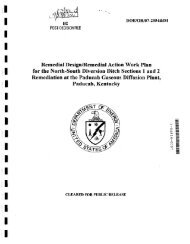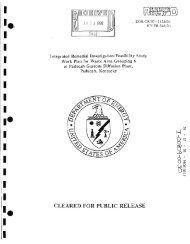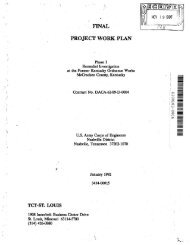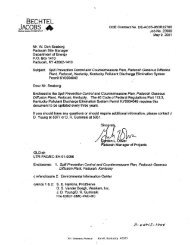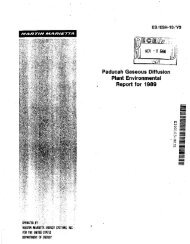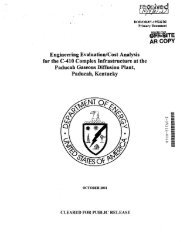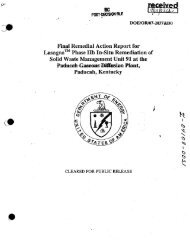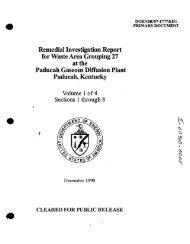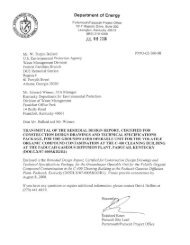1 - paducah environmental information center
1 - paducah environmental information center
1 - paducah environmental information center
You also want an ePaper? Increase the reach of your titles
YUMPU automatically turns print PDFs into web optimized ePapers that Google loves.
Paducah Site<br />
decontamination and decommissioning project<br />
planning for future implementation and<br />
planning, and planning for the additional<br />
removal and sale of surplus fluorine-generating<br />
equipment to private industry.<br />
DOE activities. The primary objective of the<br />
program is to ensure that waste materials do not<br />
migrate into the environment. Waste managed<br />
under the program is divided into the following<br />
seven categories:<br />
Technological Demonstration<br />
The Environmental Restoration Program<br />
actively supports demonstrating new remediation<br />
technologies that have been developed by<br />
private industry. In 1999, two demonstrations<br />
were conducted at the Northwest Plume<br />
Groundwater System involving possible<br />
improved methods for removal of 99'fc from the<br />
groundwater. The 3M Company provided a test<br />
system equipped with a· new, coated micropore<br />
filter designed to remove 99'fC. The filters,<br />
configured in an easily removable cartridge<br />
arrangement, were tested on a groundwater side<br />
stream in the C-612Building, Results indicated<br />
a 99'fc removal capacity· similar to the ion<br />
exchange resin currently· in use. At the time of<br />
the tests, however, the filters were not available<br />
in a size that would meet the flow requirements<br />
of the Northwest Plume Groundwater System; A<br />
second test was conducted on a new synthetic<br />
ion exchange resin developed by scientists at<br />
Oak Ridge National Laboratory. The resin is<br />
similar in function and physical characteristics to<br />
the commercial resin currently used for 99'fc<br />
removal at C-612; Preliminary laboratory<br />
studies of the synthetic resin indicated 99'fc<br />
removal efficiencies in excess of five times that<br />
of the commerCial resin. Results from a small test<br />
column placed in the C-612 facility confirmed<br />
the laboratory test results. If the synthetic resin<br />
can be manufactured in quantities and at prices<br />
meeting the Northwest Plume Groundwater<br />
System needs; its use could result in a reduction<br />
of waste for the project.<br />
Waste Management Program<br />
The Paducah Site Waste Management<br />
Program directs the safe· treatment, storage, and<br />
disposal of waste generated before July 1, 1993<br />
(Le., legacy wastes), and waste from current<br />
• Low-level radioactive waste -<br />
radioactive waste not classified as highlevel<br />
or transuranic and does not contain<br />
any components regulated by RCRA or<br />
TSCA.<br />
• Hazardous waste - waste that<br />
contains one or more of the wastes listed<br />
under RCRA or that exhibits one or more<br />
of the four RCRA hazardous<br />
characteristics: ignitability, corrosivity,<br />
reactivity, and toxicity.<br />
• Mixed waste - waste containing both<br />
hazardous and radioactive components.<br />
Mixed waste is subject to RCRA, which<br />
governs the hazardous components, and<br />
to additional regulations that govern the<br />
radioactive components.<br />
• Transuranic waste - waste that<br />
contains more than 100 nanocuries of<br />
alpha-emitting transuranic isotopes per<br />
gram of waste, with half-lives greater<br />
than 20 years.<br />
• PCB and PCB-contaminated wastes<br />
- waste containing or contaminated with<br />
PCBs, a class of synthetic organic<br />
chemicals including 209 known isomers,<br />
each with from 1 to 10 chlorine atoms on<br />
a biphenyl ring. Under TSCA<br />
regulations, PCB manufacturing was<br />
prohibited after 1978. However,<br />
continued use of PCBs is allowed<br />
provided that the use does not pose a risk<br />
to human health or the environment.<br />
Disposal of all PCB materials is<br />
regulated.<br />
• Asbestos waste - asbestos-containing<br />
materials from renovation and demolition<br />
activities.<br />
3-14<br />
Environmental Program Information



